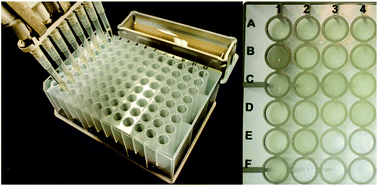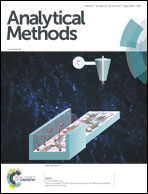Intervening factors in the performance of a naked-eye microemulsification-based method and improvements in analytical frequency
Abstract
An investigation into the use of different amphiphiles and improvements in the analytical frequency of the microemulsification-based method (MEC) are described. The results are important for improving the understanding of the method (recently proposed by our group) and the development of attractive screening analysis platforms. MEC ensures precise determination with the naked eye, providing a powerful alternative to other point-of-use experiments. Herein, the influence of different surfactant-based amphiphiles (AP) on MEC analytical performance was exhaustively evaluated for the first time, including ionic (sodium dodecylsulphate, SDS, and cetyl trimethylammonium bromide, CTAB) and neutral (triton X-100, TX-100, and tergitol NP-9, TNP-9) surfactants. The analytical performance was investigated for each of the APs in three dispersion compositions according to precision, linearity, robustness, and accuracy, which were obtained for the determination of ethanol (% v/v) in water and commercial alcoholic beverages. The data obtained for TNP-9 showed poor robustness as a function of deviations in the oil phase volume and ionic strength. Additionally, CTAB exhibited unsatisfactory robustness as a function of temperature changes. In summary, TX-100 and SDS in regions A and B, and CTAB in region A, gave the best analytical performance in the determination of ethanol in alcoholic beverages. Furthermore, a new experimental mode was developed to increase the capacity of MEC for rapid analysis of various samples. This procedure was based on semi-quantitative analyses using a 96-deep-well plate (DWP) and a multichannel micropipette to prepare the dispersions. This assembly allowed naked-eye screening analysis of up to 12 samples with a resolution of eight concentration ranges in a single run without subjective uncertainties, even after storing the DWP at 4 °C for at least five weeks. This approach has advantages including rapidity, simplicity, portability, and low cost, making it a promising alternative for continuous quality control in many industrial processes.



 Please wait while we load your content...
Please wait while we load your content...